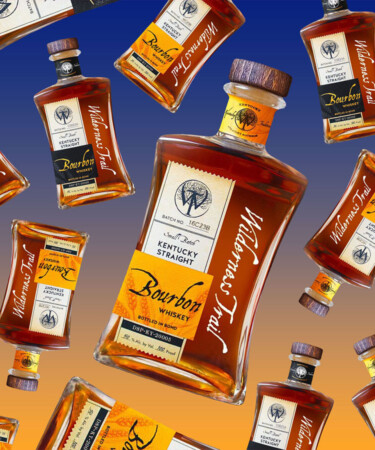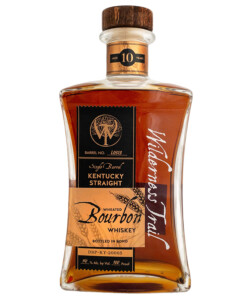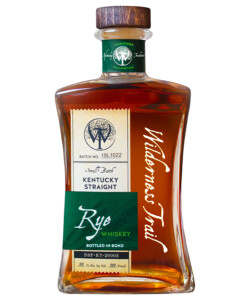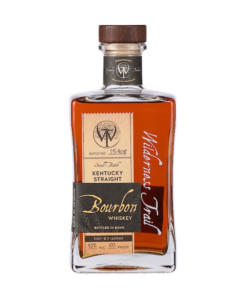Danville, Ky.’s Wilderness Trail Distillery has broken the mold of whiskey distillation with its farm-to-glass mentality. Founded in 2012 by master distillers Dr. Pat Heist and Shane Baker — a plant pathologist and a mechanical engineer, respectively — the brand brings a science-first approach to its distilling techniques and utilizes state-of-the-art manufacturing equipment with both sustainability and quality in mind.
The whiskey brand uses this machinery and these perfected techniques to distill three expressions, each of which is bottled in bond and has been produced exclusively in small batches. Since launching just over a decade ago, Wilderness Trail has been widely celebrated for its highly technical approach, including being named the 18th official stop on the Kentucky Bourbon Trail in 2020 and being dubbed the recipient of VinePair’s 2021 Next Wave Award for Spirits Brand of the Year.
Now that you know the basics, here are 11 more things you should know about Wilderness Trail.
-
One of the whiskey brand’s co-founders comes from a family of distillers.
While Baker may have pursued a career as an engineer in the field prior to shifting his science expertise to whiskey production, distilling is in his blood: His family has been distilling in Kentucky since the 1940s. In the ‘40s, Baker’s grandparents, Doris and Hubert Ballard, met at the Kentucky River Distillery while working when they were in their teens. After a 50-year career in the industry, Doris retired from the Stitzel-Weller Distillery. Baker’s father, James, was similarly involved in the industry and worked at the Canada Dry Distillery in Kentucky, which eventually became the Old Fitzgerald Distillery — now famed for the Camp Nelson Wild Turkey rickhouses. Wilderness Trail credits Baker’s family history in whiskey production for inspiring the brand’s unique yeast strains.
-
Heist and Baker met while attending the University of Kentucky.
In 1996, both Heist and Baker were students at the University of Kentucky, each pursuing their respective degrees when they met through mutual friends. Heist, who had received his bachelor’s degree in microbiology, was studying for his Ph.D. in plant pathology while Baker was pursuing his degree certification in mechanical engineering. While students, the two bonded over their shared interests, which included science and alternative rock. Heist and Baker then started a band, Fulcrum, which they credit for teaching them how to work together, play off each other’s strengths, and appeal to a crowd while maintaining an air of fun. After obtaining their degrees, Heist went onto work as a medical microbiology professor at the Kentucky College of Osteopathic Medicine while Baker worked for several years as an engineer in the field. Ten years after meeting for the first time, the two scientists made the decision to pool their resources and found their first joint operation, FermSolutions.
-
Heist and Baker started a fermenting consulting company…
Beyond science and music, the duo also discovered their shared love for American whiskey while conducting their studies. While fermentation is a crucial part of the brewing and distilling process, many producers around the globe still rely on decades-old techniques that may not optimize the flavor and texture of the yeast strains added to the mix. So, in 2006, Heist and Baker founded FermSolutions — a fermenting consulting company currently supplying yeast strains to upwards of 600 breweries and distilleries around the U.S. — to challenge these long-established practices.
Through FermSolutions, the founders have had the opportunity to work with a number of brewers and distillers to build up their programs in addition to assisting with creating numerous other fermentation-focused operations from small, start-up producers to elite, large-scale manufacturers. The consulting company also offers molecular identification of yeast and bacteria and a variety of lab services ranging from bacterial analysis to HPCL analysis, which measures residual sugars, ethanol content, glycerol, and other organic acids found in fermentation.
-
…which was the inspiration for their future distillery.
Following six years of experience consulting on various projects across the beverage alcohol industry, Heist and Baker founded fermentation-focused Wilderness Trail. Through their hands-on experience with other producers, Heist and Baker were able to gather intel on the best distillation practices to produce their own flavorful, high-quality whiskey. Each of the spirits produced by Wilderness Trail is handcrafted on-site at their 168-acre distillery from a base of seed grain corn, wheat, and rye varieties, all grown in Kentucky. The local ingredients are then paired with Wilderness Trail’s uniquely developed yeast strains before being distilled into whiskey using the distillery’s custom processes and distillation techniques. These include but are certainly not limited to the use of three copper stills (which offer flexibility in mash bill usage), an infusion machine, a high-pressure ultrafiltration sub-system, and the introduction of the sweet mash technique. Each of the three whiskeys produced by the brand — Kentucky Straight Wheated Bourbon, Kentucky Straight High-Rye Bourbon, and Kentucky Straight Rye Whiskey — are crafted from no more than 20 barrels at a time, which gives the distillers precise control over the resulting whiskies.
-
Each of the whiskeys produced at the distillery is made using the sweet mash technique.
Whereas most Kentucky whiskey distilleries utilize the sour mash technique, Wilderness Trail sets itself apart from the competition with the use of the sweet mash technique. Sour mashing is one of the most popular techniques in whiskey production and involves the use of previously used mash grains from prior distillations, called a backset, to regulate pH in new batches of whiskey, and to prevent the growth of harmful or otherwise undesired bacterias. However, the use of acidified mash (hence the name sour mash), can often come at the expense of control over the flavor profile of resulting whiskeys. This led the Wilderness Trail team to seek out a more scientifically controlled method of production. Through the sweet mash technique, each batch of cooked grain is fermented with fresh yeast alone with no backset mash involved, which reduces the risk of microbial growth and produces whiskeys the brand says are softer and more grain-flavored.
-
Wilderness Trail was also among the first to adapt a high-pressure ultrafiltration sub-system.
Reducing economic impact without sacrificing quality is a priority for the brand. That’s why the distillery adapted a high-pressure ultrafiltration sub-system to treat all water used during the distillation process, which significantly reduces the amount of energy and water necessary to produce their whiskeys. It is common for many large-scale producers to filter their water and treat used water through centrifuges — an incredibly complex process involving a number of intricate steps — to receive the leftover solids remaining in the distillate. But when this water is then poured down the drain, it still contains fine particulate matter that has the potential to clog or otherwise disrupt water treatment facilities in small towns like Danville. Heist and Baker, though, were inspired by the dairy farmers they worked with on the FermSolutions side who were using an ultrafiltration system to process waste from the cattle on their farm. Baker, along with a team of engineers at Wilderness Trail, then developed their own high-pressure ultrafiltration system specialized for whiskey production.
Where there is typically about 9 percent dry matter whole stillage remaining after standard distillation, Wilderness Trail is able to bump this number up to 17 or 18 percent dry matter with its system, which goes back to farmers as feed. The distillery, despite its relatively low production levels comparable to others in the industry, currently generates 100,000 gallons of stillage per day, making the issue of waste treatment one of high importance. By treating its waste in such a fashion, Wilderness Trail allows for that water to be recycled.
-
All of Wilderness Trail’s expressions are produced in small batches and bottled in bond.
Wilderness Trail currently produces three whiskeys in its core lineup, each of which is aged on-site in bonded rickhouses for a minimum of four years, and bottled at 100 proof. A wheated mash bill containing 64 percent corn, 24 percent wheat, and 12 percent malted barley is used in its flagship Kentucky Straight Wheated Bourbon, one of the highest ratios of wheat used to produce bourbon in Kentucky. The brand says the bourbon delivers notes of oak spices, toffee, and dark fruits. A similar mash bill is used for the Kentucky Straight High-Rye Bourbon, which sees a ratio of 64 percent corn, 24 percent rye, and 12 percent malted barley made from the distillery’s yeast strains. According to the brand, the resulting whiskey carries notes of oaked sweetness, hints of smoke, and a brambly, red-black fruit finish. The final expression, Kentucky Straight Rye Whiskey, utilizes a 56 percent rye, 33 percent corn, and 11 percent malted barley mash bill to produce a whiskey that enters the barrel at the lowest possible entry proof in Kentucky. The brand says the rye is permeated by an herbaceous flavor and long finish that evokes spearmint and floral notes. Currently, there are over 100,000 barrels aging at the Danville distillery.
-
At the distillery, select customers are able to participate in the Family Reserve Private Barrel Program.
In addition to offering hour-long tours six times daily, the distillery also allows for a select number of visitors to hand-select whiskeys poured straight from the barrel through its Family Reserve Private Barrel Program. Customers selected to participate in the program are permitted to sample a number of whiskey expressions pulled straight from the barrel rickhouses and select the one they most favor to bring home with them. The program also allows visitors to craft microblends of two to three specially selected barrels to bottle and bring home. Considering one barrel is only capable of producing around 215 bottles of whiskey, the program opens the door for über-exclusive blending and bottling opportunities.
-
The whiskey is beloved by the crypto community.
In 2020, Wilderness Trail partnered with Wave Digital Assets an SEC-registered investment advisory firm, to launch a whiskey barrel fund that may tokenize its shares in the future. Wave Digital Assets has sourced up to 2,700 barrels from the distillery since the date of launch in order to capture value appreciation associated with the aging of Kentucky whiskey. The fund is designed to be recession-resistant and see the liquidation of barrels to generate cash follows in advantageous financial times. While the fund is no longer accepting investments, those who have already invested hope to have access to aged whiskey — a historically high-performing asset class — without facing administrative or operational issues.
-
The whiskey brand was acquired by the Campari Group in 2022.
In 2022, the Campari Group purchased a 70 percent stake in Wilderness Trail in a move to further diversify its portfolio. The deal, which was valued at $600 million and finalized in December 2022, gave the Campari Group access to Wilderness Trail’s production facilities and warehouse spaces. Additionally, the agreement outlines that the remaining 30 percent interest in Wilderness Trail will be transferred to Campari’s ownership in 2031. In an October 2022 press release, Bob Kunze-Concewitz, chief executive officer of the Campari Group, said the acquisition allows for Campari to prime bourbon to become the group’s second highest-grossing category, behind only aperitifs. “
We are thrilled about our partnership with Campari Group,” Baker and Heist said in the release. “This is a win-win situation for both parties and we are very proud of this partnership and what we can achieve together with our shared vision.”



